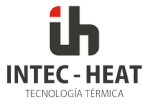What happens when a refractory material is not dried properly? This seemingly simple question hides one of the most critical phases in the installation of thermal linings in industrial furnaces and other high-temperature infrastructures.
Drying refractory materials is not an optional operation; it is a fundamental step to ensure the integrity, durability, and performance of the entire system. At Intec Heat, with over 35 years of experience in thermal treatments, we understand the importance of this operation and offer tailored solutions to ensure optimal results.
The drying process involves the controlled removal of water present in monolithic or shotcrete (sprayed concrete) refractory materials, which is vital to prevent steam pressure explosions, loss of mechanical properties, and premature failures.
This procedure must be adapted to the temperature and time curve recommended by the manufacturer, taking into account variables such as furnace type, equipment geometry, material thickness, and the availability of technical resources.
Thanks to our accumulated knowledge and a fleet of equipment like oil or gas burners, multi-ramp controllers, and digital recorders, Intec Heat develops thermal treatments and drying with millimetric precision. Our commitment to innovation is reflected in the implementation of remote control technologies and real-time curve monitoring, allowing the client full visibility of the process and ensuring the safety of industrial assets.
How is Refractory Drying Done Step by Step?
The step-by-step procedure for drying refractory materials begins with planning and analyzing the initial conditions: type of refractory, applied thickness, equipment geometry, and manufacturer recommendations. Based on this analysis, a specific drying curve is defined, setting the temperature increments, the retention times at each stage, and the adequate ventilation to expel the generated steam.
The execution is then carried out using specialized equipment. At Intec Heat, we use gas or oil burners, electric equipment, multi-ramp control systems, and strategically placed thermocouples to measure and record the thermal evolution at various points of the equipment. This monitoring allows for dynamic adjustments that prevent thermal peaks and ensure homogeneous and safe drying.
Recommended Time and Temperature for Drying Monolithic Refractories
The recommended time and temperature for drying monolithic refractories vary according to the type of material and its application. Generally, the process begins with a gentle heating stage (for example, up to 100°C over several hours), followed by progressive increments up to 300°C to 600°C, depending on the need to completely remove both physically and chemically bound water.
It is crucial to respect heating rates (usually between 15 and 25°C/hour) to avoid the formation of microcracks or material delamination. In industrial plants such as cement or steel mills, where large volumes and complex geometries are involved, these parameters are carefully adjusted. At Intec Heat, our experience across multiple sectors allows us to tailor thermal profiles for each specific application.
Common Drying Mistakes with Refractory Materials and How to Avoid Them
One of the most frequent mistakes is accelerating the drying process to save time, which can lead to internal explosions, crack formation, or delamination. Another common error is not taking into account the geometry of the equipment, which can cause uneven thermal distribution. This may result in insufficient drying in certain areas and overheating in others.
To avoid these issues, it is essential to work with qualified personnel and advanced control systems. At Intec Heat, we design each process based on thermal models and distributed sensors to ensure balanced execution. We apply thermographic analysis and finite element simulation techniques to anticipate potential risks and optimize the performance of the refractory material.
Curing vs. Drying in Refractories: Key Differences
Although often used interchangeably, curing and drying refractory materials are two distinct and complementary stages. Curing refers to the initial hydration of the binder (usually calcium aluminate cement) that occurs at room temperature for 24 to 48 hours after installation. It is a critical stage to ensure that the material gains structural strength before applying heat.
On the other hand, drying involves the controlled application of heat to remove the remaining water in the system above 100°C. The key is understanding that curing is a chemical process that occurs without external heat, while drying is a physical process that requires a precise thermal profile. Skipping either of these stages compromises the material’s effectiveness and its service life.
What Happens If a Refractory Material Is Not Properly Dried?
Failing to properly dry refractory material can have severe consequences, from the formation of internal cracks that weaken the structure to violent explosions during the furnace startup. Poor moisture removal reduces the adhesion of the refractory to the substrate, generates internal thermal stresses, and causes premature failures during operation.
In sectors like cement, offshore, steel, or energy, this translates into unplanned shutdowns, production losses, and high repair costs. At Intec Heat, we understand that proper drying execution is an investment in safety and operational efficiency. That’s why we offer technical assistance and on-site supervision services to ensure that each drying process is carried out according to the highest industry standards.
Thanks to this synergy between experience, technology, and a commitment to excellence, Intec Heat has established itself as a leader in the industrial thermal treatment sector. If you want to ensure the durability and performance of your refractory materials, contact us. We will be happy to help you achieve your goals with maximum safety and quality.
